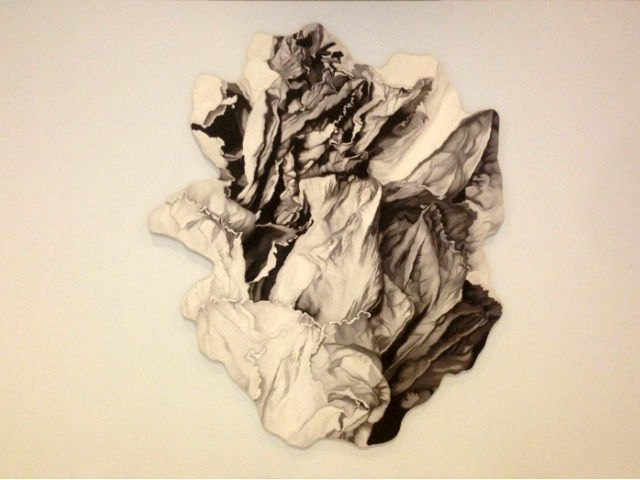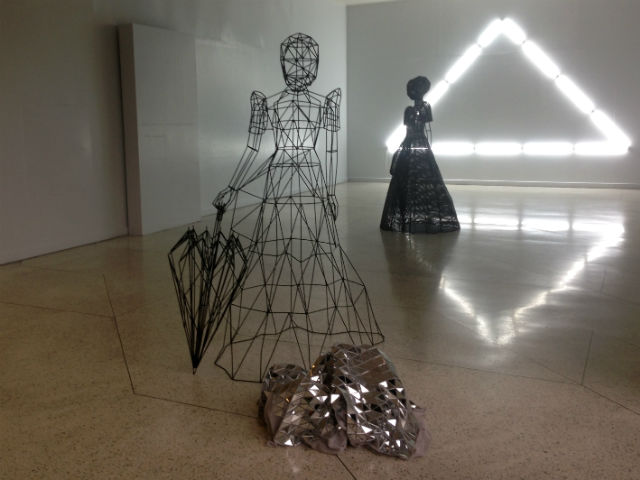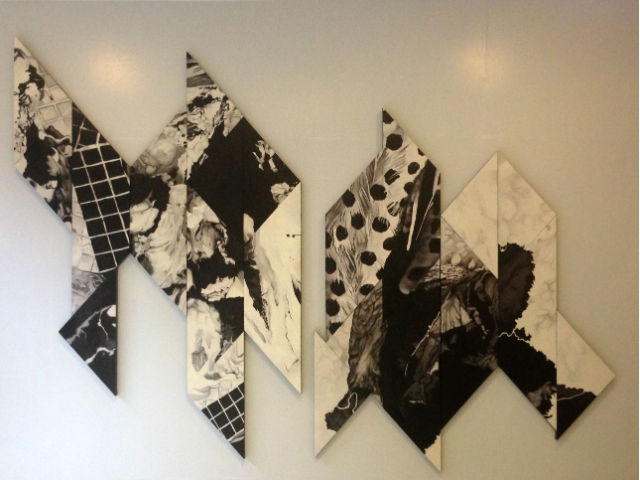Filtered By: Lifestyle
Lifestyle
Art review: Contemplating modern art in 'The Future That Was'
By CARMELA G. LAPEÑA, GMA News

The Quarried II. Photos by Carmela G. Lapeña
The dress is there and it isn't. The shape of a woman, her face obscured by a tilted umbrella. The swish of a skirt suggests wind. The scene is woven with fabric, mirrors, metal and solihiya (strands of rattan). Instead of being used for furniture, as it often is, solihiya in this case serves as part of the thread that forms several pictures, collectively forming "The Future That Was."
The title comes from the final chapter of Robert Hughes' "The Shock of the New," in which he explains modern art. The chapter "The Future That Was" refers to the life cycle of Western art: of emergence, flourish, and decline; and the exhibit is the artist Patricia Perez Eustaquio's "musings on the structures and ideas that produce, frame and promote art and design."
At the woman's feet, the shape of a rock, flowing so that it appears to be a heap of discarded fabric. A pattern of laser-cut mirror triangles catching the afternoon light.
There is another shape of a woman, dressed in the shape of terno. One dainty arm lifts her skirt's fabric ever so slightly. A triangle of bright lights frames the woman, but the writing on the wall says "She stood contemplating the square." The square is there, but only if one looks closely enough.

The title comes from the final chapter of Robert Hughes' "The Shock of the New," in which he explains modern art. The chapter "The Future That Was" refers to the life cycle of Western art: of emergence, flourish, and decline; and the exhibit is the artist Patricia Perez Eustaquio's "musings on the structures and ideas that produce, frame and promote art and design."
At the woman's feet, the shape of a rock, flowing so that it appears to be a heap of discarded fabric. A pattern of laser-cut mirror triangles catching the afternoon light.
There is another shape of a woman, dressed in the shape of terno. One dainty arm lifts her skirt's fabric ever so slightly. A triangle of bright lights frames the woman, but the writing on the wall says "She stood contemplating the square." The square is there, but only if one looks closely enough.

"The Future That Was (On Reflection)" and "The Future That Was (Shadow, Overshadow)". In the background, "Polyform II" and "She Stood Contemplating the Square".
There is, too, another woman, less there it seems as the gaps in the frame of her shape are larger. She too, holds an umbrella, but it is folded and she may or may not be contemplating the mirrored shape of rock at her feet.
Another shape of a woman sits on a bench, hands folded on her lap. She faces another bench, on which gold and black fabric spills out of a seat, a chair without legs.
As the figures pose in apparent contemplation, one feels as if one had stumbled upon a scene where time is frozen.
In another room, shapes bloom into black and white paintings, the pieces folding together and apart like lost parts of a puzzle.
"Eustaquio covers her objects in varied surfaces: mannequins in solihiya, ambiguous rock formations in laser-cut mirrors and wood, while paintings are attempts at wrapping varied shapes in similarly articulated, textured surfaces. Overall, it is an exercise in exuberance and stylization in an attempt to examine the framework of art production, aesthetics and taste, and in so doing raise the question of what informs art and design," the notes read.
In "The Future That Was," the artist covers and reveals — dresses that flow over curves, rocks that reflect, lights the frame objects and slip through empty spaces.

Another shape of a woman sits on a bench, hands folded on her lap. She faces another bench, on which gold and black fabric spills out of a seat, a chair without legs.
As the figures pose in apparent contemplation, one feels as if one had stumbled upon a scene where time is frozen.
In another room, shapes bloom into black and white paintings, the pieces folding together and apart like lost parts of a puzzle.
"Eustaquio covers her objects in varied surfaces: mannequins in solihiya, ambiguous rock formations in laser-cut mirrors and wood, while paintings are attempts at wrapping varied shapes in similarly articulated, textured surfaces. Overall, it is an exercise in exuberance and stylization in an attempt to examine the framework of art production, aesthetics and taste, and in so doing raise the question of what informs art and design," the notes read.
In "The Future That Was," the artist covers and reveals — dresses that flow over curves, rocks that reflect, lights the frame objects and slip through empty spaces.

"Polygon I" and "Untitled".
The exhibit invites the viewer to contemplate, as the shapes appear to contemplate. Curator Dr. Patrick Flores writes: "According to Hughes, modernity, instead of serving as the lightning rod of the future, became in the culmination of its career, the rudder of its time: a 'winding down, academization, and a sense of stagnancy which fostered doubts about the role, the necessity, and even the survival of art.'
It is at this seam of time where Eustaquio, perhaps through the fragments of her pyramid-shaped paintings, ponders the blur of art as it repeats its destiny. And it is here where she musters up the resolve to act upon it: to shape, to sew, to cut, and most of all, to drape over bare armature of iron: to create the folds of performance, that particular turn of fabric into a dimension, a flair, a postura."
The pieces, arranged without their names, can be seen one by one or in relation to each other. A catalog maps the pieces out for the viewer, but the figures do not seem to need their names. After a while, one begins to imagine they might turn their heads, move their lips. One tends to think of questions beginning with what or why, but the figures remain still.
The audience ponders as the artist does. In these shapes that bloom and fold, rise and fall, perhaps the questions are answers enough. — BM, GMA News
"The Future That Was" runs from July 23 to August 24. The exhibition is presented at the Jorge Vargas Museum, University of the Philippines Diliman, in cooperation with Silverlens.
It is at this seam of time where Eustaquio, perhaps through the fragments of her pyramid-shaped paintings, ponders the blur of art as it repeats its destiny. And it is here where she musters up the resolve to act upon it: to shape, to sew, to cut, and most of all, to drape over bare armature of iron: to create the folds of performance, that particular turn of fabric into a dimension, a flair, a postura."
The pieces, arranged without their names, can be seen one by one or in relation to each other. A catalog maps the pieces out for the viewer, but the figures do not seem to need their names. After a while, one begins to imagine they might turn their heads, move their lips. One tends to think of questions beginning with what or why, but the figures remain still.
The audience ponders as the artist does. In these shapes that bloom and fold, rise and fall, perhaps the questions are answers enough. — BM, GMA News
"The Future That Was" runs from July 23 to August 24. The exhibition is presented at the Jorge Vargas Museum, University of the Philippines Diliman, in cooperation with Silverlens.
Tags: artreview, patriciaeustaquio
More Videos
Most Popular



